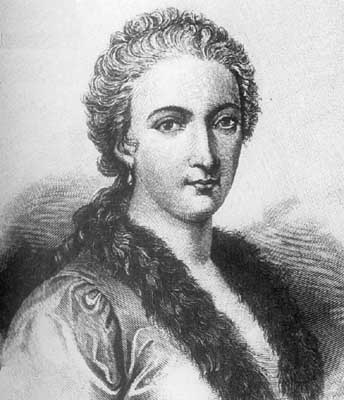She is credited with writing the first book discussing both differential and integral calculus and was an honorary member of the faculty at the University of Bologna.[1]
She devoted the last four decades of her life to studying theology (especially patristics) and to charitable work and serving the poor. This extended to helping the sick by allowing them entrance in to her home where she set up a hospital.[2]
Maria Teresa
Agnesi Pinottini, clavicembalist and composer, was her sister.
Maria
Gaetana Agnesi was born in Milan, to a wealthy and literate family.[3][4][5] Her father Pietro Agnesi, a University of Bologna mathematics professor,[6] wanted to elevate his family into the Milanese nobility. In order to achieve his goal he had married Anna Fortunata Brivio in 1717. Her mother's death provided her the excuse to retire from public life. She took over management of the household.
Agnesi's diploma from Università di Bologna
Maria was recognized early on as a child prodigy; she could speak both Italian and French at five years of age. By her eleventh birthday she had also learned Greek, Hebrew, Spanish, German, and Latin, and was referred to as the "Seven-Tongued Orator".[6] She even educated her younger brothers. When she was nine years old she composed and delivered an hour-long speech in Latin to some of the most distinguished intellectuals of the day. The subject was women's right to be educated.
Agnesi suffered a mysterious illness at the age of 12 that was attributed to her excessive studying and was prescribed vigorous dancing and horseback riding. This treatment did not work - she began to experience extreme convulsions, after which she was encouraged to pursue moderation. By age fourteen she was studying ballistics and geometry.[6] When she was fifteen her father began to regularly gather in his house a circle of the most learned men in Bologna,[citation needed] before whom she read and maintained a series of theses on the most abstruse philosophical questions. Records of these meetings are given in Charles de Brosses' Lettres sur l'Italie and in the Propositiones Philosophicae, which her father had published in 1738 as an account of her final performance, where she defended 190 theses.[6]
Maria was very shy in nature and did not like these meetings.[citation needed]
Her father remarried twice after Maria's mother died, and
Maria Agnesi ended up the eldest of 23 children, including her half-siblings. In addition to her performances and lessons, her responsibility was to teach her siblings. This task kept her from her own goal of entering a convent, as she had become strongly religious. Although her father refused to grant this wish, he agreed to let her live from that time on in an almost conventual semi-retirement, avoiding all interactions with society and devoting herself entirely to the study of mathematics.[6] During that time,
Maria studied both differential and integral calculus. Fellow philosophers thought she was extremely beautiful and her family was recognized as one of the wealthiest in Milan.
Maria became a professor at the University of Bologna.
Contributions to mathematics
Instituzioni analitiche
First page of Instituzioni analitiche (1748)
The most valuable result of her labours was the Instituzioni analitiche ad uso della gioventù italiana, which was published in Milan in 1748 and "was regarded as the best introduction extant to the works of Euler." [7] In the work, she worked on integrating mathematical analysis with algebra.[6] The first volume treats of the analysis of finite quantities and the second of the analysis of infinitesimals. A French translation of the second volume by P. T. d'Antelmy, with additions by Charles Bossut (1730–1814), was published in Paris in 1775; and Analytical Institutions, an English translation of the whole work by John Colson (1680–1760), the Lucasian Professor of Mathematics at Cambridge, "inspected" by John Hellins, was published in 1801 at the expense of Baron Maseres.[8] The work was dedicated to Empress
Maria Theresa, who thanked
Agnesi with the gift of a diamond ring, a personal letter, and a diamond and crystal case. Many others praised her work, including Pope Benedict XIV, who wrote her a complimentary letter and sent her a gold wreath and a gold medal.[6]









